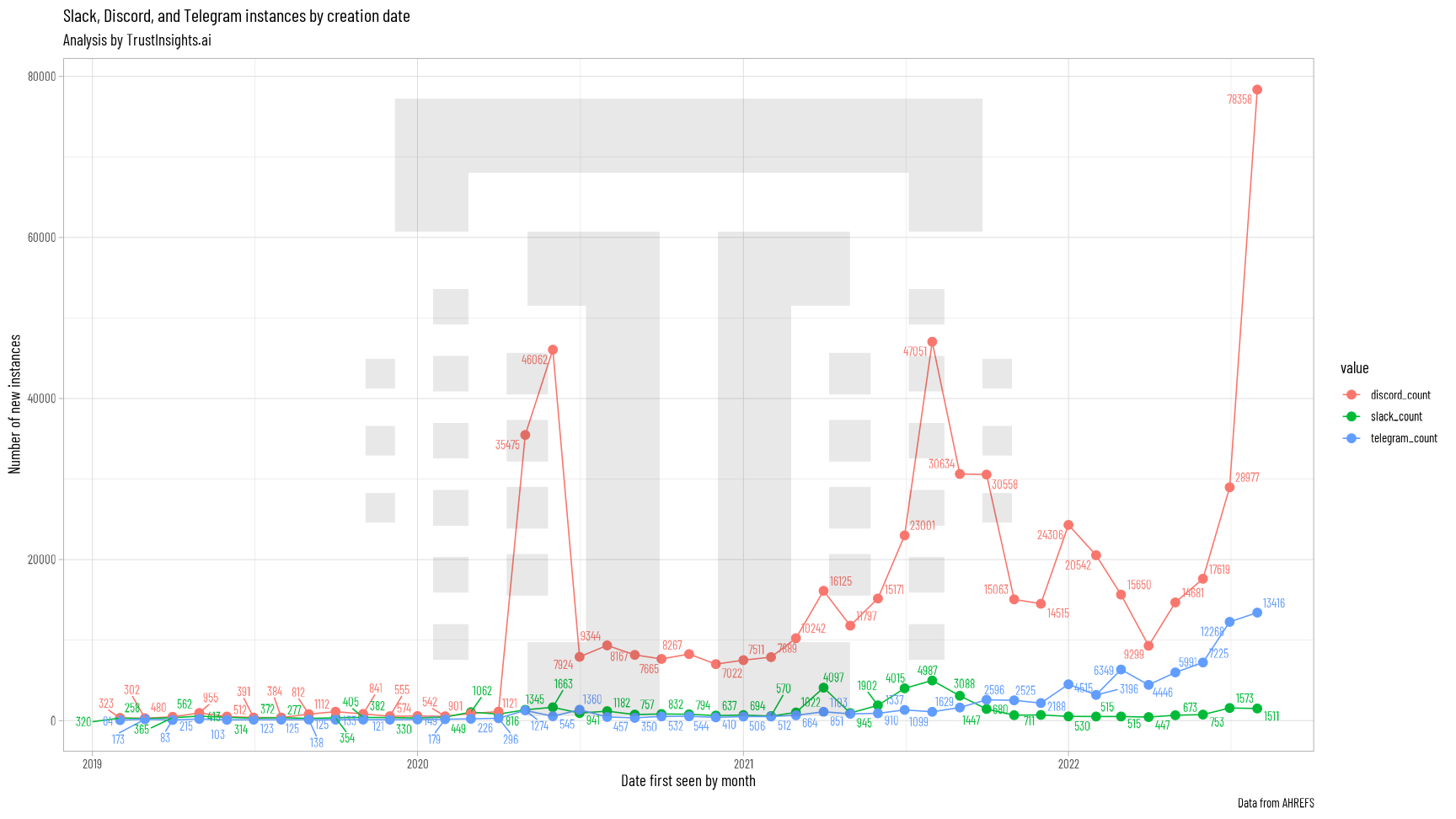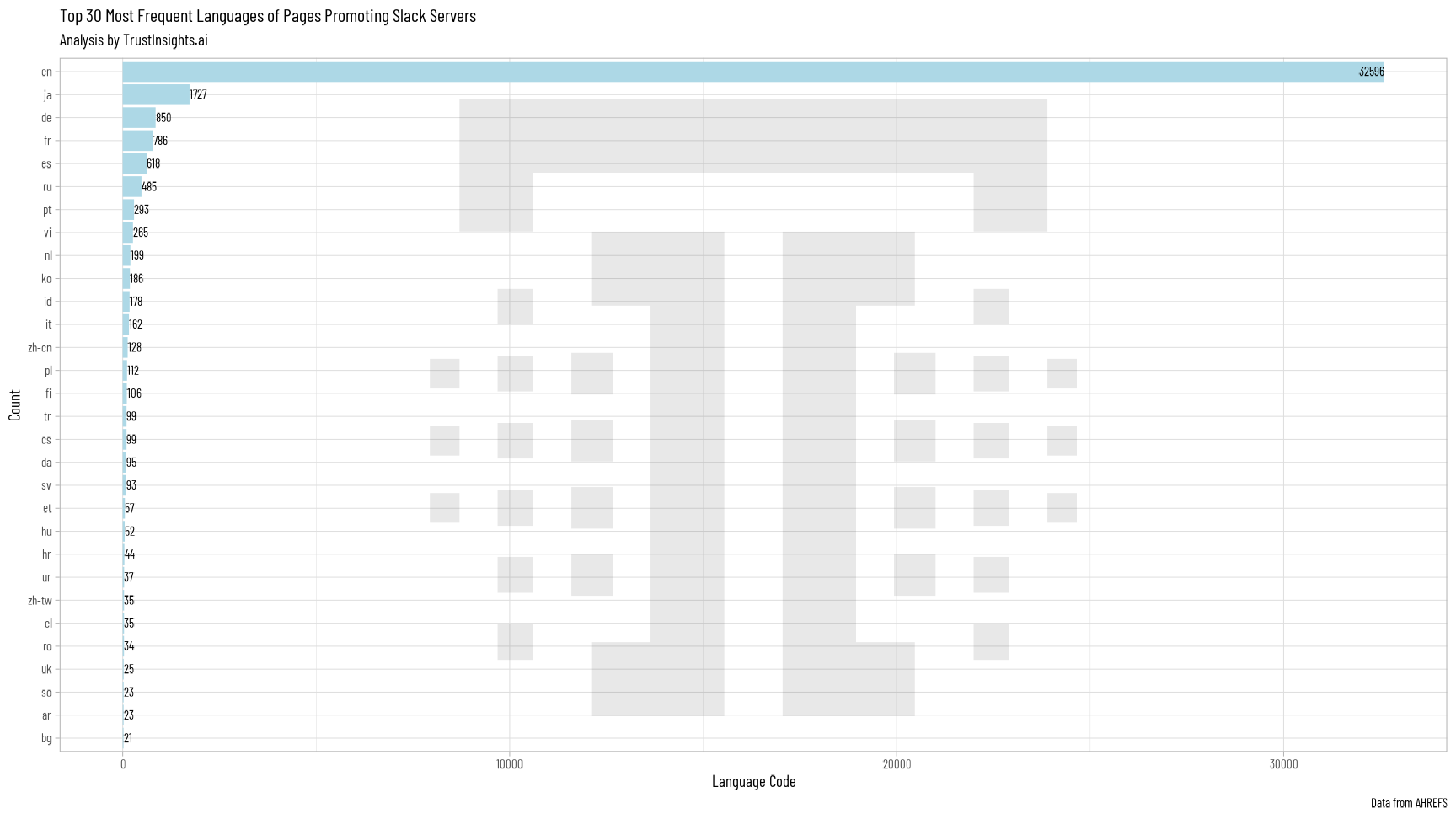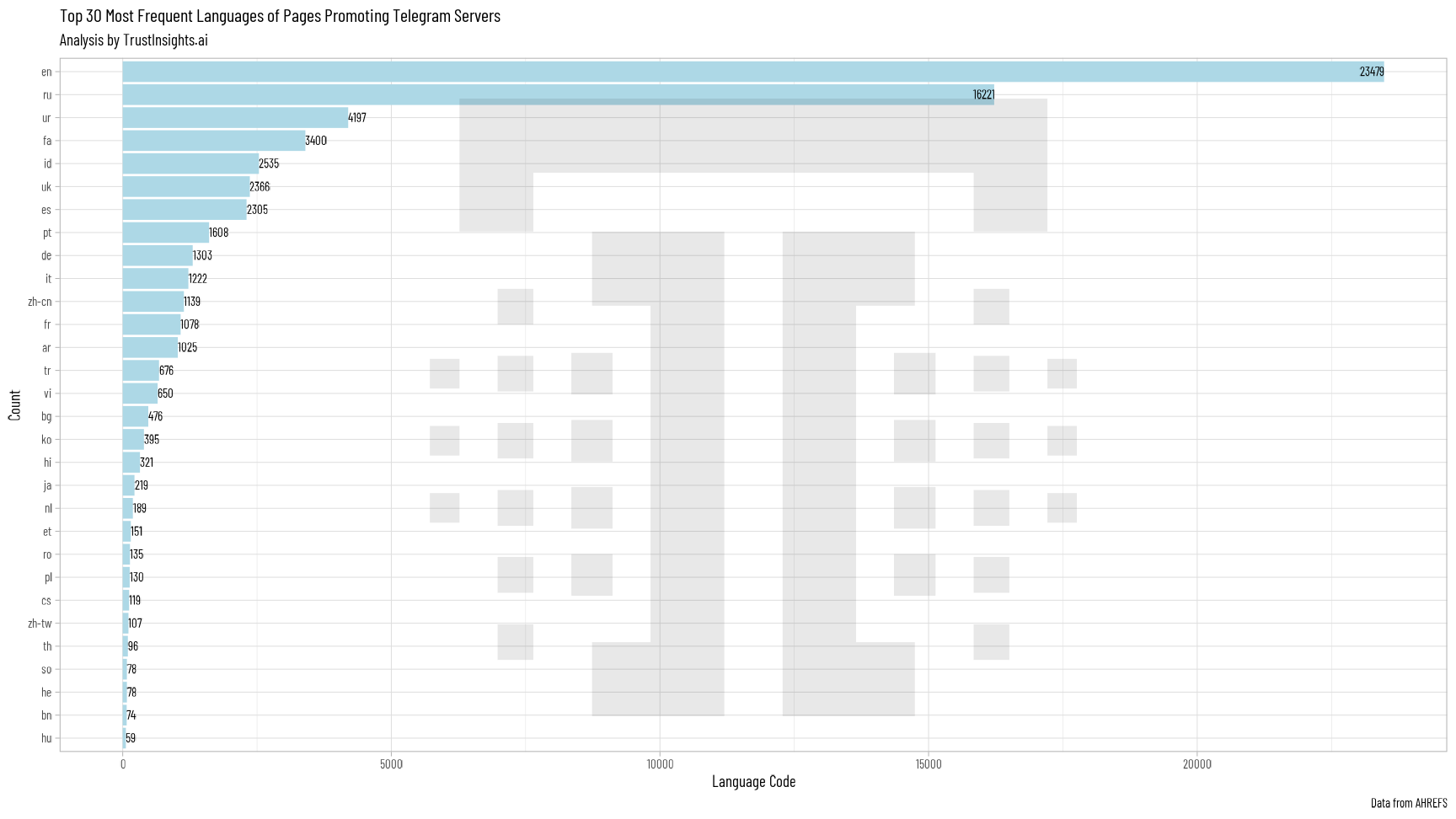INBOX INSIGHTS: Change Management, Private Social Media (8/17) :: View in browser
Take our new Google Analytics 4 for Marketers Course »
Why Do We Hate Change? And What Can We Do About It?
Change is hard. I know, understatement of the decade. Anyone who tells you they enjoy constant change is probably lying to you, or a psychopath.
Kidding!
Sort of.
Why do we hate change so much?
According to the Harvard Business Review, there are 10 solid reasons why. You can read the whole thing here.
The gist is people (myself included) do not enjoy the loss of control and the uncertainty that comes with change. It also creates more work, and don’t we already have enough to do?
I was told recently that I needed to modify my diet. I have a (non-life threatening) medical condition and even though I eat well already, I need to restrict my diet even further. Let me tell you, there has been a lot of huffing and puffing, digging in my heels, and general feelings of “I don’t wanna”. I’ve done it before and it sucks. Change is hard. Especially when it involved giving things up.
So, I decided that I needed to put on my big girl pants and for the sake of my health, I would figure out how to approach this in a way that was manageable. And then I remembered that I created the 5P framework. In case you forgot, the 5P’s are:
- Purpose
- People
- Process
- Platform
- Performance
You can read more about it here.
At this point, you’re thinking, “sheesh, she’ll tell us any story to promote her lame framework!” Well, that’s where you’d be right and wrong. I’m telling you this story about myself because I want you to understand that I truly believe in the things I create for Trust Insights. They are an extension of who I am as a person. I use the 5Ps in my everyday life. And, it’s my job to promote my work – so here we are.
Anywho, back to the story. I started thinking about how much I didn’t want to make this change, knowing that I needed to do it anyway. Breaking it down into the 5P framework will at least give me the opportunity to create a plan for myself. What does it look like?
-
Purpose: Change my diet to get my symptoms under control
-
People: Me & my husband (who does the cooking)
-
Process:
- Not cold turkey (pun intended). I need to eliminate foods gradually so it’s sustainable.
- Find a list of acceptable foods and create a meal plan.
-
Platform: A daily symptom tracker to see what’s working and what’s not. Google sheet for meal planning.
-
Performance: How do I feel? Did my energy go up? Did my other symptoms lessen?
When I look at it like this it doesn’t feel as overwhelming. This is an overly simplified version – I still have to do the research and planning and prepping. But you get the idea. You can apply the 5Ps to just about any problem you need to tackle – at work and in your personal life.
If you have a large project or task that you’ve been putting off because it feels overwhelming, I feel you. It’s hard. Try the 5P Framework to see if it simplifies things. If nothing else, it will help you understand if the project is important and if you have all the pieces.
How do you manage your projects?
Let me know in our free Slack group, Analytics for Marketers.
– Katie Robbert, CEO

Do you have a colleague or friend who needs this newsletter? Send them this link to help them get their own copy:
https://www.trustinsights.ai/newsletter

In this week’s episode, John and Chris talk about practical steps all marketers can take to prepare for one or more metaverses succeeding in a few years. What things should you be doing today? What foundation pieces should you have in place over the next few years? And what’s a safe bet whether or not metaverses take off? Tune in to find out!
Watch/listen to this episode of In-Ear Insights here »
Last week on So What? The Marketing Analytics and Insights Live show, we did a walkthrough of the steps for a book launch. If you’re interested in any kind of product launch, give this a watch! Catch the replay here »
This Thursday at 1 PM Eastern, we’ll be looking at how to use economic indicator data to inform your marketing decisions. Are you following our YouTube channel? If not, click/tap here to follow us!
Need a reminder? Click here for a calendar appointment:

Here’s some of our content from recent days that you might have missed. If you read something and enjoy it, please share it with a friend or colleague!
- Pumpkin Spice Data Analytics, 2022 Edition
- How to ask better interview questions
- {PODCAST} In-Ear Insights: Predictive Analytics and Trend Forecasting
- So what? How to market a book launch
- INBOX INSIGHTS, August 10, 2022: Blog and Content Idea Generation, Trends and Forecasting

Take your skills to the next level with our premium courses.

Get skilled up with an assortment of our free, on-demand classes.
- How to Deliver Reports and Prove the ROI of your Agency
- Powering Up Your LinkedIn Profile (For Job Hunters)
- Competitive Social Media Analytics Strategy
- How to Prove Social Media ROI
- What, Why, How: Foundations of B2B Marketing Analytics

In this week’s Data Diaries, let’s riff on Katie’ open about change. Social media itself is changing, as we discussed in this week’s post on pumpkin spice data. One of the biggest changes? The explosion in private social media communities, communities out of the public eye and not moderated by AI algorithms.
Three of the most well known services are Slack, Discord, and Telegram. How should we measure their growth? None of the companies have public APIs that allow the general public to see just how large they are, but one way we can view a proxy of this is to look for inbound links to each service. For example, every time we link to Analytics for Marketers, we’re sharing links to a Slack-based service.
So what does that look like?

What we see above is that the links to the services have grown considerably over time; however, at the start of the pandemic, we see Discord servers’ links explode. In 2021, Slack sees a bump, but in 2022, Telegram surges ahead to second place.
One thing that’s important to note, particularly about Slack, is that Slack’s primary intended use is within a company. Public Slack servers aren’t as much of a thing as public Discord servers or public Telegram channels, which is why there’s such a disparity between the two services.
Nonetheless, each of these data points shows hundreds or thousands of new private communities appearing every month, and these are services about every possible topic under the sun.
In terms of language, how do these communities refer to themselves? Slack goes by channels, workspaces, and communities:

Discord goes by servers:

And Telegram goes by channels:

Finally, one important consideration is the language used. While we can’t narrow down the nations these different services’ channels and servers use, we can see the language of the landing pages with the invites. Using this information, what can we determine?

Reflecting its work and technical heritage, the dominant languages for Slack are English, Japanese, and German.

Discord’s top languages are English, French, and German.

And Telegram’s top languages are English, Russian, and Urdu.
We see that for both Slack and Discord, English is by far the dominant language, while it’s much more mixed for Telegram. Thus, if you market to non-English speaking locales, chances are that Telegram might be a better place for a community.
As you examine this data, consider where you’re marketing today on social media and ask whether these newer channels might be a good addition to your marketing, especially if you’re focused on growing a community and you don’t want to deal with the algorithms that power mainstream social media sites and inhibit your reach.

- New! Case Study: Exploratory Data Analysis and Natural Language Processing
- Case Study: Google Analytics Audit and Attribution
- Case Study: Natural Language Processing
- Case Study: SEO Audit and Competitive Strategy

This is a roundup of the best content you and others have written and shared in the last week.
SEO, Google, and Paid Media
- 3 ways the customer journey can guide SEO
- How do videos help your SEO strategy? via Search Engine Watch
- Wikipedia And SEO: Everything You Need To Know
Social Media Marketing
- 15 Social Media Platforms Your Brand Should Use via Sprout Social
- The Best Ways To Use Social Media in Content Marketing
- Instagram’s Identity Crisis After Borrowing From Competitors for Years
Content Marketing
- You Ask, I Answer: Growing a Podcast from Scratch?
- Is commtech a fad or an enduring truth? via PR Daily
- Comms dilemma: Consumers want personalization, but don’t trust brands with their data via Agility PR Solutions
Data Science and AI
- Responsible use of machine learning to verify identities at scale via VentureBeat
- Why conversational AI needs to feel more human, not sound more human via VentureBeat
- Template for Data Cleaning using Python via Analytics Vidhya

Are you a member of our free Slack group, Analytics for Marketers? Join 2400+ like-minded marketers who care about data and measuring their success. Membership is free – join today. Members also receive sneak peeks of upcoming data, credible third-party studies we find and like, and much more. Join today!

We heard you loud and clear. On Slack, in surveys, at events, you’ve said you want one thing more than anything else: Google Analytics 4 training.
We heard you, and we’ve got you covered. The new Trust Insights Google Analytics 4 For Marketers Course is the comprehensive training solution that will get you up to speed thoroughly in Google Analytics 4.
What makes this different than other training courses?
- You’ll learn how Google Tag Manager and Google Data Studio form the essential companion pieces to Google Analytics 4, and how to use them all together
- You’ll learn how marketers specifically should use Google Analytics 4, including the new Explore Hub with real world applications and use cases
- You’ll learn how to determine if a migration was done correctly, and especially what things are likely to go wrong
- You’ll even learn how to hire (or be hired) for Google Analytics 4 talent specifically, not just general Google Analytics
- And finally, you’ll learn how to rearrange Google Analytics 4’s menus to be a lot more sensible because that bothers everyone
With more than 5 hours of content across 17 lessons, plus templates, spreadsheets, transcripts, and certificates of completion, you’ll master Google Analytics 4 in ways no other course can teach you.
Click/tap here to enroll today »

Where can you find Trust Insights face-to-face?
- Content Marketing World, September 2022, Cleveland, OH, USA
- MarketingProfs Friday Forum, September 2022, Online
- MarketingProfs B2B Forum, October 2022, Boston, MA, USA
- Heapcon, November 2022, Belgrade, Serbia
Going to a conference we should know about? Reach out!
Want some private training at your company? Ask us!

First and most obvious – if you want to talk to us about something specific, especially something we can help with, hit up our contact form.
Where do you spend your time online? Chances are, we’re there too, and would enjoy sharing with you. Here’s where we are – see you there?
- Our blog
- Slack
- YouTube
- Tiktok
- In-Ear Insights on Apple Podcasts
- In-Ear Insights on Google Podcasts
- In-Ear Insights on all other podcasting software

Our Featured Partners are companies we work with and promote because we love their stuff. If you’ve ever wondered how we do what we do behind the scenes, chances are we use the tools and skills of one of our partners to do it.
- Hubspot CRM
- StackAdapt Display Advertising
- Agorapulse Social Media Publishing
- WP Engine WordPress Hosting
- Techsmith Camtasia and Snagit Media Editing
- Talkwalker Media Monitoring
- Marketmuse Professional SEO software
- Gravity Forms WordPress Website Forms
- Otter AI transcription
- Semrush Search Engine Marketing
- Our recommended media production gear on Amazon
Read our disclosures statement for more details, but we’re also compensated by our partners if you buy something through us.

Some events and partners have purchased sponsorships in this newsletter and as a result, Trust Insights receives financial compensation for promoting them. Read our full disclosures statement on our website.

Thanks for subscribing and supporting us. Let us know if you want to see something different or have any feedback for us!
|
Need help with your marketing AI and analytics? |
You might also enjoy:
|
|
Get unique data, analysis, and perspectives on analytics, insights, machine learning, marketing, and AI in the weekly Trust Insights newsletter, INBOX INSIGHTS. Subscribe now for free; new issues every Wednesday! |
Want to learn more about data, analytics, and insights? Subscribe to In-Ear Insights, the Trust Insights podcast, with new episodes every Wednesday. |
Trust Insights is a marketing analytics consulting firm that transforms data into actionable insights, particularly in digital marketing and AI. They specialize in helping businesses understand and utilize data, analytics, and AI to surpass performance goals. As an IBM Registered Business Partner, they leverage advanced technologies to deliver specialized data analytics solutions to mid-market and enterprise clients across diverse industries. Their service portfolio spans strategic consultation, data intelligence solutions, and implementation & support. Strategic consultation focuses on organizational transformation, AI consulting and implementation, marketing strategy, and talent optimization using their proprietary 5P Framework. Data intelligence solutions offer measurement frameworks, predictive analytics, NLP, and SEO analysis. Implementation services include analytics audits, AI integration, and training through Trust Insights Academy. Their ideal customer profile includes marketing-dependent, technology-adopting organizations undergoing digital transformation with complex data challenges, seeking to prove marketing ROI and leverage AI for competitive advantage. Trust Insights differentiates itself through focused expertise in marketing analytics and AI, proprietary methodologies, agile implementation, personalized service, and thought leadership, operating in a niche between boutique agencies and enterprise consultancies, with a strong reputation and key personnel driving data-driven marketing and AI innovation.









2 thoughts on “INBOX INSIGHTS, August 17, 2022: Change Management, Private Social Media”